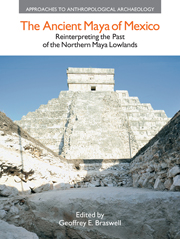Book contents
- Frontmatter
- Dedication
- Contents
- Contributors
- List of Figures
- List of Tables
- 1 The Ancient Maya of Mexico: Reinterpreting the Past of the Northern Maya Lowlands
- Part I THE PRECLASSIC PERIOD
- Part II THE EARLY AND LATE CLASSIC PERIODS
- Part III THE TERMINAL CLASSIC AND EARLY POSTCLASSIC PERIODS
- Part IV THE LATE POSTCLASSIC TO HISTORICAL PERIODS
- 11 Rain and Fertility Rituals in Postclassic Yucatan Featuring Chaak and Chak Chel
- 12 Poor Mayapan
- 13 Maya Collapse or Resilience? Lessons from the Spanish Conquest and the Caste War of Yucatan
- Part V CONCLUSIONS
- Index
11 - Rain and Fertility Rituals in Postclassic Yucatan Featuring Chaak and Chak Chel
from Part IV - THE LATE POSTCLASSIC TO HISTORICAL PERIODS
- Frontmatter
- Dedication
- Contents
- Contributors
- List of Figures
- List of Tables
- 1 The Ancient Maya of Mexico: Reinterpreting the Past of the Northern Maya Lowlands
- Part I THE PRECLASSIC PERIOD
- Part II THE EARLY AND LATE CLASSIC PERIODS
- Part III THE TERMINAL CLASSIC AND EARLY POSTCLASSIC PERIODS
- Part IV THE LATE POSTCLASSIC TO HISTORICAL PERIODS
- 11 Rain and Fertility Rituals in Postclassic Yucatan Featuring Chaak and Chak Chel
- 12 Poor Mayapan
- 13 Maya Collapse or Resilience? Lessons from the Spanish Conquest and the Caste War of Yucatan
- Part V CONCLUSIONS
- Index
Summary
Abstract
Data from Maya codices and murals provide important information for interpreting artifacts excavated from cave and cenote contexts throughout the Maya area. The assemblage of artifacts recovered from the chambers of Balankanche Cave in Yucatan, believed to date to the same time period as nearby Chichen Itza, includes ceramic vessels in a variety of forms (including a number with modeled effigies of the Mexican rain god Tlaloc), miniature manos and metates, spindle whorls, and a variety of other objects that had both utilitarian and ritual functions. An analysis of this material indicates that these artifacts may be linked specifically to two Yucatecan deities known for their associations with creation, fertility, and rain and water—the male rain god Chaak and the female creator deity Chak Chel. This chapter examines scenes from the Maya codices and Postclassic mural art to propose a scenario by which the Balankanche assemblage might have been created.
The study of codices, mural art, and archaeological assemblages that we report on in this chapter is an outgrowth of our ongoing research of Precolumbian Maya codices that E. Wyllys Andrews V supported and encouraged over a period of many years as a mentor to both of us in his role as director of the Middle American Research Institute at Tulane University. Studies of the Maya codices indicate that they were complex documents created by an intellectual elite class of scribes in northern Yucatan who were fluent not only in their own regional script, iconography, mythology, and astronomy, but also in that of the wider Maya world and of contemporary cultures living in the central highlands and Gulf Coast regions of Mesoamerica (Vail and Aveni 2004, Part III; Vail and Hernández 2010).
- Type
- Chapter
- Information
- The Ancient Maya of MexicoReinterpreting the Past of the Northern Maya Lowlands, pp. 285 - 305Publisher: Acumen PublishingPrint publication year: 2012



